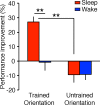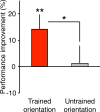Trained-feature-specific offline learning by sleep in an orientation detection task
- PMID: 31622472
- PMCID: PMC6797476
- DOI: 10.1167/19.12.12
Trained-feature-specific offline learning by sleep in an orientation detection task
Abstract
Training-induced performance gains in a visual perceptual learning (VPL) task that take place during sleep are termed "offline performance gains." Offline performance gains of VPL so far have been reported in the texture discrimination task and other discrimination tasks. This raises the question as to whether offline performance gains on VPL occur exclusively in discrimination tasks. The present study examined whether offline performance gains occur in detection tasks. In Experiment 1, subjects were trained on a Gabor orientation detection task. They were retested after a 12-hr interval, which included either nightly sleep or only wakefulness. Offline performance gains occurred only after sleep on the trained orientation, not on an untrained orientation. In Experiment 2, we tested whether offline performance gains in the detection task occur over a nap using polysomnography. Moreover, we tested whether sigma activity during non-rapid eye movement (NREM) sleep recorded from occipital electrodes, previously implicated in offline performance gains of the texture discrimination task, was associated with the degree of offline performance gains of the Gabor orientation detection task. We replicated offline performance gains on the trained orientation in the detection task over the nap. Sigma activity during NREM sleep was significantly larger in the occipital electrodes relative to control electrodes in correlation with offline performance gains. The results suggest that offline performance gains occur over the sleep period generally in VPL. Moreover, sigma activity in the occipital region during NREM sleep may play an important role in offline performance gains of VPL.
Figures




Similar articles
-
Sleep-Dependent Facilitation of Visual Perceptual Learning Is Consistent with a Learning-Dependent Model.J Neurosci. 2022 Mar 2;42(9):1777-1790. doi: 10.1523/JNEUROSCI.0982-21.2021. Epub 2022 Jan 12. J Neurosci. 2022. PMID: 35022218 Free PMC article.
-
Reward does not facilitate visual perceptual learning until sleep occurs.Proc Natl Acad Sci U S A. 2020 Jan 14;117(2):959-968. doi: 10.1073/pnas.1913079117. Epub 2019 Dec 31. Proc Natl Acad Sci U S A. 2020. PMID: 31892542 Free PMC article.
-
Brief periods of NREM sleep do not promote early offline gains but subsequent on-task performance in motor skill learning.Neurobiol Learn Mem. 2017 Nov;145:18-27. doi: 10.1016/j.nlm.2017.08.006. Epub 2017 Aug 19. Neurobiol Learn Mem. 2017. PMID: 28830703
-
The visual scoring of sleep and arousal in infants and children.J Clin Sleep Med. 2007 Mar 15;3(2):201-40. J Clin Sleep Med. 2007. PMID: 17557427 Review.
-
The Visual Scoring of Sleep in Infants 0 to 2 Months of Age.J Clin Sleep Med. 2016 Mar;12(3):429-45. doi: 10.5664/jcsm.5600. J Clin Sleep Med. 2016. PMID: 26951412 Free PMC article. Review.
Cited by
-
Complementary contributions of non-REM and REM sleep to visual learning.Nat Neurosci. 2020 Sep;23(9):1150-1156. doi: 10.1038/s41593-020-0666-y. Epub 2020 Jul 20. Nat Neurosci. 2020. PMID: 32690968 Free PMC article.
-
Priority coding in the visual system.Nat Rev Neurosci. 2022 Jun;23(6):376-388. doi: 10.1038/s41583-022-00582-9. Epub 2022 Apr 11. Nat Rev Neurosci. 2022. PMID: 35410358 Review.
-
Estimating the Trial-by-Trial Learning Curve in Perceptual Learning with Hierarchical Bayesian Modeling.Res Sq [Preprint]. 2023 Nov 23:rs.3.rs-3649060. doi: 10.21203/rs.3.rs-3649060/v1. Res Sq. 2023. PMID: 38045291 Free PMC article. Preprint.
-
Enabling identification of component processes in perceptual learning with nonparametric hierarchical Bayesian modeling.J Vis. 2024 May 1;24(5):8. doi: 10.1167/jov.24.5.8. J Vis. 2024. PMID: 38780934 Free PMC article.
-
Sleep-Dependent Facilitation of Visual Perceptual Learning Is Consistent with a Learning-Dependent Model.J Neurosci. 2022 Mar 2;42(9):1777-1790. doi: 10.1523/JNEUROSCI.0982-21.2021. Epub 2022 Jan 12. J Neurosci. 2022. PMID: 35022218 Free PMC article.
References
-
- Agnew H. W, Jr., Webb W. B, Williams R. L. The first night effect: An EEG study of sleep. Psychophysiology. (1966);2(3):263–266. - PubMed
-
- Benjamini Y, Hochberg Y. Controlling the false discovery rate: A practical and powerful approach to multiple testing. Journal of the Royal Statistical Society, Series B: Methodological. (1995);57(1):289–300.
Publication types
MeSH terms
Grants and funding
LinkOut - more resources
Full Text Sources
Research Materials

